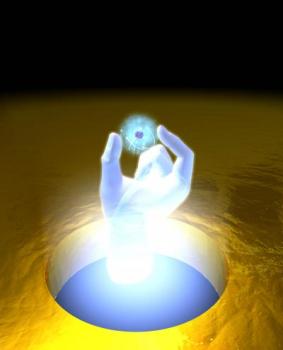Feb 12 2013
Researchers from the Institute of Photonic Sciences (ICFO), in collaboration with the CSIC and Macquarie University in Australia, have developed a new technique, similar to the MRI but with a much higher resolution and sensitivity, which has the ability to scan individual cells. In an article published in Nature Nanotech, and highlighted by Nature, ICFO Prof. Romain Quidant explains how this was accomplished using artificial atoms, diamond nanoparticles doped with nitrogen impurity, to probe very weak magnetic fields such as those generated in some biological molecules.
 This image illustrates the nanomanipulation of an artificial atom. Credit: ICFO
This image illustrates the nanomanipulation of an artificial atom. Credit: ICFO
The conventional MRI registers the magnetic fields of atomic nuclei in our bodies which have been previously excited by an external electromagnetic field. The collective response of all of these atoms makes it possible to diagnose and monitor the evolution of certain diseases. However, this conventional technique has a diagnostic resolution on a millimetric scale. Smaller objects do not give enough signal to be measured.
The innovative technique proposed by the group led by Dr. Quidant significantly improves the resolution at the nanometer scale (nearly one million times smaller than the millimeter), making it possible to measure very weak magnetic fields, such as those created by proteins. "Our approach opens the door for the performance of magnetic resonances on isolated cells which will offer new sources of information and allow us to better understand the intracellular processes, enabling noninvasive diagnosis," explains Michael Geiselmann, ICFO researcher who conducted the experiment. Until now, it has only been possible to reach this resolution in the laboratory, using individual atoms at temperatures close to the absolute zero (approx. -273 degrees Celsius.)
Individual atoms are structures that are highly sensitive to their environment, with a great ability to detect nearby electromagnetic fields. The challenge these atoms present is that they are so small and volatile that in order to be manipulated, they must be cooled to temperatures near the absolute zero. This complex process requires an environment that is so restrictive that it makes individual atoms unviable for potential medical applications. Artificial atoms used by Quidant and his team are formed by a nitrogen impurity captured within a small diamond crystal. "This impurity has the same sensitivity as an individual atom but is very stable at room temperature due to its encapsulation. This diamond shell allows us to handle the nitrogen impurity in a biological environment and, therefore, enables us to scan cells" argues Dr. Quidant.
To trap and manipulate these artificial atoms, researchers use laser light. The laser works like tweezers, leading the atoms above the surface of the object to study and extract information from its tiny magnetic fields.
The emergence of this new technique could revolutionize the field of medical imaging, allowing for substantially higher sensitivity in clinical analysis, an improved capacity for early detection of diseases, and thus a higher probability for successful treatment.